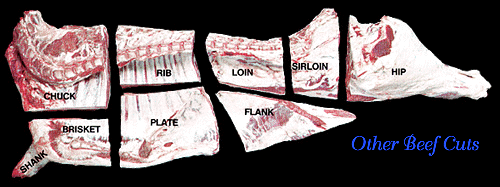Beef
Information about beef
By
Joe O'Connell,
Food Writer
First posted 3 July 2003 at 1840 GMT
Last updated 13 October 2003 at 1815 GMT
LOS ANGELES, California — Chefs who aspire to Steak
Perfection face complex issues
in the selection and preparation of beef steaks. The
most popular beef cut for steak is the New York strip or the
tenderloin, but there are many other beef
cuts that are often used for steak. This will explain some of the facts
concerning beef steaks. See the
U.S. Department of Agriculture's website for more information.
Breeds of cattle
There are dozens of breeds of cattle in the world. Many
breeds were developed for milk cattle, like the Holstein. Others
were developed for meat production, such as the Angus.
Oklahoma State University maintains a
website for cattle breeds.
Number and names of beef sections and cuts
There are about 300 cuts of beef that are regularly marketed, but
there are more than 1,000 names for these cuts. Further
confusion arises because names and labels differ from one part of the
country to another.
Barbecue cooks should learn the basics about beef cuts, USDA
Grading, labeling and tenderization rules, and the like.
IMPS/NAMP identification numbers
In order to eliminate the confusing names given to meat cuts in
different regions and by different vendors, a uniform system of
designating cuts has been developed, and each beef, pork and lamb cut
is identifiable by a numbering system under the IMPS/NAMP system.
IMPS means the USDA approved Institutional Meat Purchase
Specifications (IMPS) for fresh beef, pork and lamb. NAMP means
the North American Meat Processors Association, which has been issuing
a Meat Buyer's Guide since 1963, and has been issuing the Poultry
Buyers Guide for the last two years.
The
USDA IMPS for Fresh Beef is a 2-MB PDF file, available for
downloading (which is practical only with a broadband connection and
not with a slow modem). The IMPS describes in great detail each
cut of meat, with illustrations and photographs. Other
IMPS guides are available for other meat.
The following explanations and descriptions of beef sections and
cuts include (in parentheses) the designated numbers of the
USDA Institutional Meat Purchase Specifications (IMPS). For
example, the top sirloin is IMPS/NAMP No. 181A -- which will be shown
as "top sirloin (181A)".
Beef primal sections
After a beef carcass (100) has been eviscerated and chilled, the
carcass (100) is cut down the middle so that there are two sides of
beef (101). Each side of beef (101) is separated
into the forequarter (102) and the hindquarter (155).
Then each quarter is separated ("broken" is the word used in the
industry) into the
nine primal cuts (each of which includes its IMPS/NAMP number).
These primal parts are the wholesale cuts which are customarily
distributed to retailers. The first five primal cuts are from
the forequarter (102):
- Beef Rib, Primal (103)
- Beef Chuck, Square Cut (113)
- Beef Foreshank (117)
- Beef Brisket (118)
- Beef Plate, Short Plate (121)
The next four primal cuts are from the hindquarter (155):
- Beef Round, Primal (158)
- Beef Loin, Short Loin (173)
- Beef Loin, Sirloin (181)
- Beef Flank, Flank Steak (193)
Here is an illustration of the primal cuts in a side of beef:

Note that the
illustration above is Canadian and has slightly different terminology,
although Canada uses the same sub-primal names and IMPS numbering as
the US. Here the "Hip" is known in the US as the "Round".
The retail cuts from each of the primal sections which
are of interest to barbecue cooks will be discussed briefly.
Perhaps the best site for learning beef muscles and retail cuts ("beef
myology") is the University of Nebraska
Beef Myology
website.
Related information:
|